|
|
测试框架
?
1
2
3
4
5
6
7
8
9
10
11
12
13
14
15
16
17
18
19
20
21 |
CentOS-6.6-x86_64(minimal)
puppet-3.7.4
nagios-4.0.8.tar.gz
nagios-plugins-2.0.3.tar.gz
nrpe-2.15.tar.gz
192.168.188.10 mirrors.redking.com
192.168.188.20 master.redking.com
192.168.188.20 nagios.redking.com
192.168.188.31 agent1.redking.com
192.168.188.32 agent2.redking.com
192.168.188.33 agent3.redking.com |
Puppet 要求所有机器有完整的域名(FQDN),如果没有 DNS 服务器提供域名的话,可以在两台机器上设置主机名(注意要先设置主机名再安装 Puppet,因为安装 Puppet 时会把主机名写入证书,客户端和服务端通信需要这个证书),因为我配置了DNS,所以就不用改hosts了,如果没有就需要改hosts文件指定。
1.关闭selinux,iptables,并设置ntp 采用CentOS-6.6-x86_64.iso进行minimal最小化安装
关闭selinux
?
1
2
3
4
5
6
7
8
9
10
11
12
13
14
15
16
17
18
19
20
21
22
23
24
25
26
27
28
29
30
31
32
33
34
35
36
37
38
39
40
41
42
43
44
45
46
47 |
[iyunv@master ~]# cat /etc/selinux/config
# This file controls the state of SELinux on the system.
# SELINUX= can take one of these three values:
# enforcing - SELinux security policy is enforced.
# permissive - SELinux prints warnings instead of enforcing.
# disabled - No SELinux policy is loaded.
SELINUX=enforcing
# SELINUXTYPE= can take one of these two values:
# targeted - Targeted processes are protected,
# mls - Multi Level Security protection.
SELINUXTYPE=targeted
[iyunv@master ~]# sed -i '/SELINUX/ s/enforcing/disabled/g' /etc/selinux/config
[iyunv@master ~]# cat /etc/selinux/config
# This file controls the state of SELinux on the system.
# SELINUX= can take one of these three values:
# enforcing - SELinux security policy is enforced.
# permissive - SELinux prints warnings instead of enforcing.
# disabled - No SELinux policy is loaded.
SELINUX=disabled
# SELINUXTYPE= can take one of these two values:
# targeted - Targeted processes are protected,
# mls - Multi Level Security protection.
SELINUXTYPE=targeted
[iyunv@master ~]# setenforce 0 |
停止iptables
?
1
2
3
4
5
6
7
8
9
10
11
12
13
14
15
16
17
18
19
20
21
22
23
24
25
26
27 |
[iyunv@node1 ~]# chkconfig --list |grep tables
ip6tables 0:off 1:off 2:on 3:on 4:on 5:on 6:off
iptables 0:off 1:off 2:on 3:on 4:on 5:on 6:off
[iyunv@node1 ~]# chkconfig ip6tables off
[iyunv@node1 ~]# chkconfig iptables off
[iyunv@node1 ~]# service ip6tables stop
ip6tables: Setting chains to policy ACCEPT: filter [ OK ]
ip6tables: Flushing firewall rules: [ OK ]
ip6tables: Unloading modules: [ OK ]
[iyunv@node1 ~]# service iptables stop
iptables: Setting chains to policy ACCEPT: filter [ OK ]
iptables: Flushing firewall rules: [ OK ]
iptables: Unloading modules: [ OK ]
[iyunv@node1 ~]# |
设置ntp
?
1
2
3
4
5
6
7
8
9
10
11
12
13
14
15 |
[iyunv@master ~]# ntpdate pool.ntp.org
[iyunv@master ~]# chkconfig --list|grep ntp
ntpd 0:off 1:off 2:off 3:off 4:off 5:off 6:off
ntpdate 0:off 1:off 2:off 3:off 4:off 5:off 6:off
[iyunv@master ~]# chkconfig ntpd on
[iyunv@master ~]# service ntpd start
Starting ntpd: [ OK ]
[iyunv@master ~]# |
2.安装puppet服务 puppet不在CentOS的基本源中,需要加入 PuppetLabs 提供的官方源:
?
1
2
3
4
5 |
[iyunv@master ~]# wget http://yum.puppetlabs.com/el/6/products/x86_64/puppetlabs-release-6-7.noarch.rpm
[iyunv@master ~]# rpm -ivh puppetlabs-release-6-7.noarch.rpm
[iyunv@master ~]# yum update -y |
在 master上安装和启用 puppet 服务:
?
1
2
3
4
5
6
7
8
9
10
11
12
13
14
15 |
[iyunv@master ~]# yum install -y puppet-server
[iyunv@master ~]# chkconfig puppet on
[iyunv@master ~]# chkconfig puppetmaster on
[iyunv@master ~]# service puppet start
Starting puppet agent: [ OK ]
[iyunv@master ~]# service puppetmaster start
Starting puppetmaster: [ OK ]
[iyunv@master ~]# |
在clients上安装puppet客户端
?
1
2
3
4
5 |
[iyunv@agent1 ~]# yum install -y puppet
[iyunv@agent1 ~]# chkconfig puppet on
[iyunv@agent1 ~]# service puppet start |
3.配置puppet
对于puppet 客户端,修改/etc/puppet/puppet.conf,指定master服务器

并重启puppet服务
?
1 |
[iyunv@agent1 ~]# service puppet restart |
4.Client申请证书 服务端自动签发证书设置 设置master自动签发所有的证书,我们只需要在/etc/puppet目录下创建 autosign.conf文件。(不需要修改 /etc/puppet/puppet.conf文件,因为我默认的autosign.conf 文件的位置没有修改)
?
1
2
3
4
5
6
7
8
9
10
11
12
13 |
[iyunv@master ~]# cat > /etc/puppet/autosign.conf <<EOF
> *.redking.com
> EOF
[iyunv@master ~]# service puppetmaster restart
Stopping puppetmaster: [ OK ]
Starting puppetmaster: [ OK ]
[iyunv@master ~]# |
这样就会对所有来自fisteam2.com的机器的请求,都自动签名。 client需要向服务器端发出请求, 让服务器对客户端进行管理. 这其实是一个证书签发的过程. 第一次运行 puppet 客户端的时候会生成一个 SSL 证书并指定发给 Puppet 服务端, 服务器端如果同意管理客户端,就会对这个证书进行签发,可以用这个命令来签发证书,由于我们已经在客户端设置了server地址,因此不需要跟服务端地址
?
1 |
[iyunv@agent1 ~]# puppet agent --test |

就可以申请证书了,由于我配置的自动签发证书,所以直接就签发了,在服务端执行
?
1 |
[iyunv@master ~]# puppet cert list --all |

Nagios服务器安装
1.安装Nagios相关依赖包
?
1 |
[iyunv@master ~]# yum install -y httpd php gcc glibc glibc-common gd gd-devel openssl-devel |
2.创建Nagios用户与组
?
1
2
3 |
[iyunv@master ~]# useradd -m nagios
[iyunv@master ~]# passwd nagios |
创建nagcmd用户组以执行来自Web接口命令,并添加nagios和apache用户到此用户组
?
1
2
3
4
5 |
[iyunv@master ~]# groupadd nagcmd
[iyunv@master ~]# usermod -a -G nagcmd nagios
[iyunv@master ~]# usermod -a -G nagcmd apache |
3.下载Nagios和Plugins软件包
http://www.nagios.org/download/下载Nagios Core和Nagios Plugins

4.编译安装Nagios
?
1
2
3 |
[iyunv@master tmp]# tar zxf nagios-4.0.8.tar.gz
[iyunv@master tmp]# cd nagios-4.0.8 |
#运行Nagios配置脚本,并把nagcmd更改为之前所创建的组
?
1 |
[iyunv@master nagios-4.0.8]# ./configure --with-command-group=nagcmd |
#编译Nagios源码
?
1 |
[iyunv@master nagios-4.0.8]# make all |
#安装二进制文件、init脚本文件、sample配置文件,设置外部命令目录权限
?
1
2
3
4
5
6
7 |
[iyunv@master nagios-4.0.8]# make install
[iyunv@master nagios-4.0.8]# make install-init
[iyunv@master nagios-4.0.8]# make install-config
[iyunv@master nagios-4.0.8]# make install-commandmode |
5.修改配置文件
样式配置文件位于/usr/local/nagios/etc目录,可以更改email地址
?
1 |
[iyunv@master nagios-4.0.8]# vim /usr/local/nagios/etc/objects/contacts.cfg |
6.配置Web界面
在Apache的conf.d目录中安装Nagios Web配置文件
?
1 |
[iyunv@master nagios-4.0.8]# make install-webconf |
创建nagiosadmin帐号登录Nagios Web接口
?
1
2
3
4
5
6
7 |
[iyunv@master nagios-4.0.8]# htpasswd -c /usr/local/nagios/etc/htpasswd.users nagiosadmin
[iyunv@master nagios-4.0.8]# service httpd start
Starting httpd: [ OK ]
[iyunv@master nagios-4.0.8]# chkconfig httpd on |
开启httpd服务使配置生效并设置开机自启

7.编译安装Nagios Plugins
?
1
2
3
4
5
6
7 |
[iyunv@master tmp]# tar zxvf nagios-plugins-2.0.3.tar.gz
[iyunv@master tmp]# cd nagios-plugins-2.0.3
[iyunv@master nagios-plugins-2.0.3]# ./configure --with-nagios-user=nagios --with-nagios-group=nagios
[iyunv@master nagios-plugins-2.0.3]# make && make install |
8.编译安装Nrpe
?
1
2
3
4
5
6
7
8
9
10
11 |
[iyunv@master tmp]# tar zxvf nrpe-2.15.tar.gz
[iyunv@master nrpe-2.15]# ./configure
[iyunv@master nrpe-2.15]# make all
[iyunv@master nrpe-2.15]# make install-plugin
[iyunv@master nrpe-2.15]# make install-daemon
[iyunv@master nrpe-2.15]# make install-daemon-config |

9.启动Nagios
本机监控HTTP SSH的Notifications显示警告错误,解决方法
?
1
2
3
4
5
6
7
8
9
10
11
12
13
14
15
16
17
18
19
20
21
22
23
24
25
26
27
28
29
30
31
32
33
34
35
36
37
38
39 |
[iyunv@master ~]# vim /usr/local/nagios/etc/objects/localhost.cfg
# Define a service to check SSH on the local machine.
# Disable notifications for this service by default, as not all users may have SSH enabled.
define service{
use local-service ; Name of service template to use
host_name localhost
service_description SSH
check_command check_ssh
notifications_enabled 1 #改为1,即可
}
# Define a service to check HTTP on the local machine.
# Disable notifications for this service by default, as not all users may have HTTP enabled.
define service{
use local-service ; Name of service template to use
host_name localhost
service_description HTTP
check_command check_http
notifications_enabled 1 #改为1,即可
}
[iyunv@master ~]# touch /var/www/html/index.html |
启动Nagios之前测试配置文件
?
1 |
[iyunv@master ~]# /usr/local/nagios/bin/nagios -v /usr/local/nagios/etc/nagios.cfg |

启动Nagios、nrpe并设置开机自启
?
1
2
3
4
5
6
7
8
9
10
11
12
13
14
15
16
17
18
19
20
21
22
23 |
[iyunv@master ~]# chkconfig nagios --add
[iyunv@master ~]# chkconfig --list |grep nagios
nagios 0:off 1:off 2:off 3:on 4:on 5:on 6:off
[iyunv@master ~]# chkconfig nagios on
[iyunv@master ~]# service nagios start
Starting nagios: done.
[iyunv@master ~]# echo "/usr/local/nagios/bin/nrpe -c /usr/local/nagios/etc/nrpe.cfg -d" >> /etc/rc.d/rc.local
[iyunv@master nrpe-2.15]# /usr/local/nagios/bin/nrpe -c /usr/local/nagios/etc/nrpe.cfg -d
[iyunv@master nrpe-2.15]# netstat -tunpl |grep nrpe
tcp 0 0 0.0.0.0:5666 0.0.0.0:* LISTEN 70100/nrpe
tcp 0 0 :::5666 :::* LISTEN 70100/nrpe
[iyunv@master nrpe-2.15]# |
执行/usr/local/nagios/libexec/check_nrpe -H 127.0.0.1检查连接是否正常

使用之前定义的nagiosadmin帐号与密码登录Nagios,地址:http://192.168.188.20/nagios/
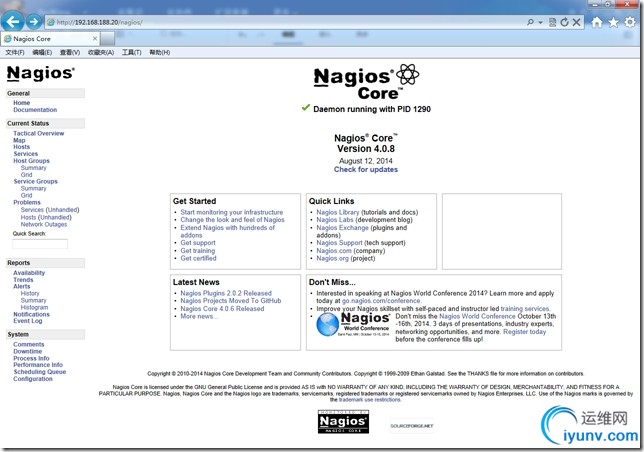

创建Nagios客户端监控
1.Puppet Master安装相应模块
Nagios没有目前没有提供官方软件源,在批量部署时可以使用第三方epel源,采用Example42所提供的puppet-nrpe来实现Linux服务器批量部署。部署客户端使用官方3个模块:epel、nrpe、puppi。
epel模块用于安装nrpe软件,nrpe模块用于收集主机信息,puppi属于Example42模块组件,使用Example42模块时都需要加载此模块。
Puppi是一个Puppet模块和CLI命令,他可以标准化和自动化快速部署应用程序,并提供快速和标准查询命令,检查系统资源。
?
1
2
3
4
5
6
7
8
9
10
11
12
13 |
[iyunv@master ~]# git clone https://github.com/puppetlabs/puppetlabs-stdlib /etc/puppet/modules/stdlib
[iyunv@master ~]# git clone https://github.com/example42/puppi /etc/puppet/modules/puppi
[iyunv@master ~]# git clone https://github.com/example42/puppet-nrpe /etc/puppet/modules/nrpe
[iyunv@master ~]# puppet module install stahnma/epel
[iyunv@master ~]# vim /etc/puppet/puppet.conf
[master]
modulepath = /etc/puppet/modules/ |
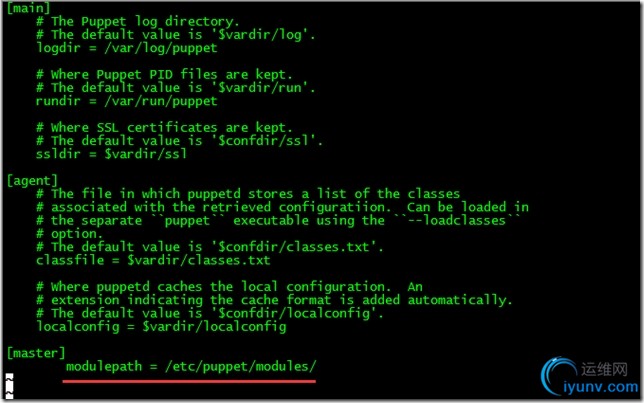
2.创建agent节点组配置文件
?
1
2
3
4
5
6
7
8
9
10
11
12
13
14
15
16
17
18
19
20
21
22
23
24
25
26
27 |
[iyunv@master ~]# mkdir /etc/puppet/manifests/nodes
[iyunv@master ~]# vim /etc/puppet/manifests/nodes/agentgroup.pp
node /^agent\d+\.redking\.com$/ {
include stdlib
include epel
class { 'puppi': }
class { 'nrpe':
require => Class['epel'],
allowed_hosts => ['127.0.0.1',$::ipaddress,'192.168.188.20'],
template => 'nrpe/nrpe.cfg.erb',
}
}
[iyunv@master ~]# vim /etc/puppet/manifests/site.pp
import "nodes/agentgroup.pp" |
3.配置Nagios添加agent.redking.com主机监控
修改/usr/local/nagios/etc/objects/commands.cfg
command_name check_nrpe ——定义命令名称为check_nrpe,services.cfg必须使用
command_line $USER1$/check_nrpe -H $HOSTADDRESS$ -c $ARG1$ ——用$USER1$代替/usr/local/nagios/libexec
这是定义实际运行的插件程序.这个命令行的书写要完全按照check_nrpe这个命令的用法.不知道用法的就用check_nrpe –h查看; -c后面带的$ARG1$参数是传给nrpe daemon执行的检测命令,它必须是nrpe.cfg中所定义的5条命令中的其中一条。
?
1
2
3
4
5
6
7
8
9
10
11 |
[iyunv@master ~]# vim /usr/local/nagios/etc/objects/commands.cfg
# 'check_nrpe' command definition
define command{
command_name check_nrpe
command_line $USER1$/check_nrpe -H $HOSTADDRESS$ -c $ARG1$
} |
修改/usr/local/nagios/etc/nagios.cfg
?
1
2
3
4
5
6
7 |
[iyunv@master ~]# vim /usr/local/nagios/etc/nagios.cfg
cfg_file=/usr/local/nagios/etc/objects/agent1.redking.com.cfg
cfg_file=/usr/local/nagios/etc/objects/agnet2.redking.com.cfg
cfg_file=/usr/local/nagios/etc/objects/agent3.redking.com.cfg |
增加agent1~3.redking.com.cfg配置文件
?
1
2
3
4
5
6
7
8
9
10
11
12
13
14
15
16
17
18
19
20
21
22
23
24
25
26
27
28
29
30
31
32
33
34
35
36
37
38
39
40
41
42
43
44
45
46
47
48
49
50
51
52
53
54
55
56
57
58
59
60
61 |
# vim /usr/local/nagios/etc/objects/agent1.redking.com.cfg
define host{
use linux-server
host_name agent1.redking.com
alias agent1.redking.com
address 192.168.188.31
}
define service{
use generic-service
host_name agent1.redking.com
service_description PING
check_command check_ping!100.0,20%!500.0,60%
}
define service{
use generic-service
host_name agent1.redking.com
service_description Current Users
check_command check_nrpe!check_users!10!5
}
define service{
use generic-service
host_name agent1.redking.com
service_description Current Load
check_command check_nrpe!check_load!15,10,5!30,25,20
}
define service{
use generic-service
host_name agent1.redking.com
service_description Swap Usage
check_command check_nrpe!check_swap!20!40
} |
检测Nagios服务并重启使配置生效
?
1
2
3
4
5 |
[iyunv@master ~]# /usr/local/nagios/bin/nagios -v /usr/local/nagios/etc/nagios.cfg
[iyunv@master ~]# service nagios restart
[iyunv@master ~]# service puppetmaster restart |

客户端测试
?
1 |
[iyunv@agent1 ~]# puppet agent --test |
客户端自动部署nrpe

下面我们来看下客户端自动化部署nrpe后采集信息的nagios监控界面



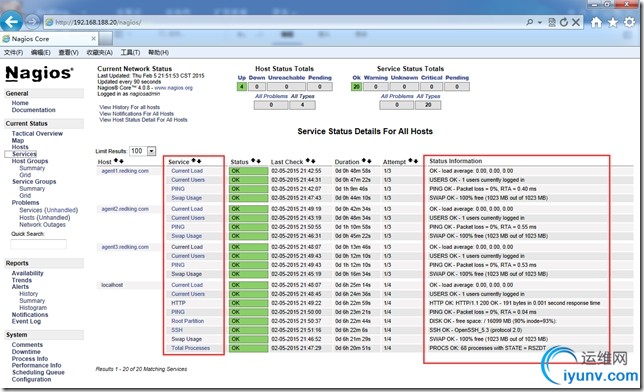
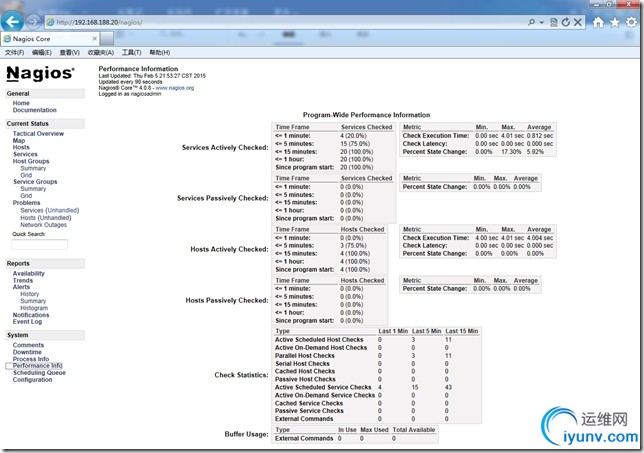
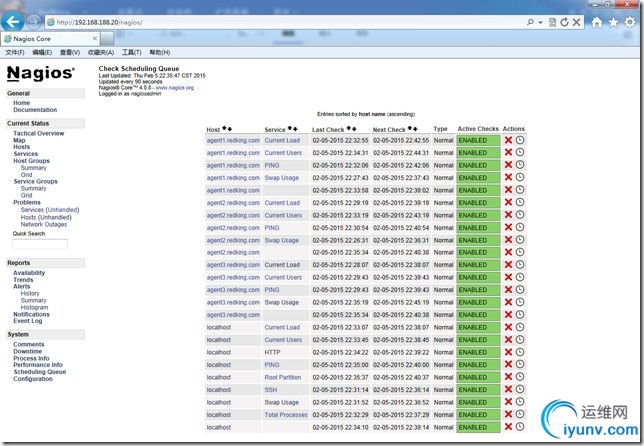
NRPE模块中定义的nrpe.cfg包含大量脚本,我们可以直接拿来使用当然也可以自己修改nrpe.cfg.erb模板内容。在批量部署时可以分别采用自己编写的模块或者现有模块来实现,利用现有模块几乎能实现系统管理日常工作中90%任务,剩余的10%我们可以根据生产业务来自己定制。

========================END=================================
http://redking.blog.iyunv.com/27212/1612136 |
|